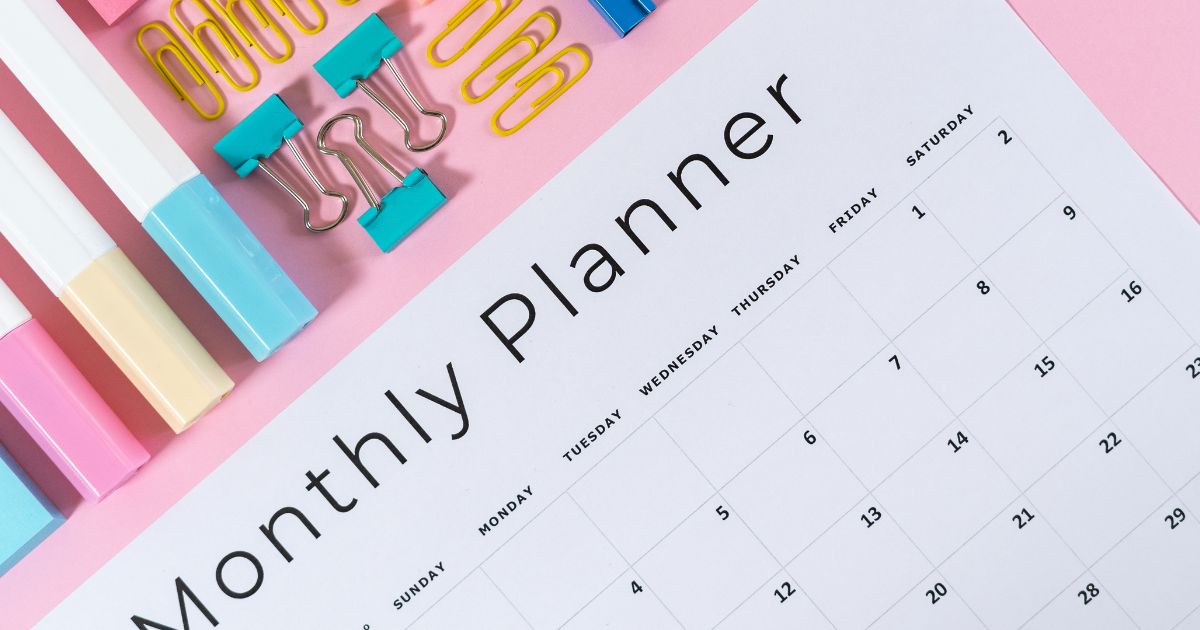The last beach days and late sunsets are winding down, which means it’s the perfect moment to shift into back-to-school planning. A little preparation now will save stress in September and set a strong tone for the months ahead.
This guide walks you through practical steps to map your year, organize your space and schedule, spark your child’s motivation, and choose a homeschool approach and curriculum that fit your family.
What this post will help you do
- Build a simple, flexible plan for your homeschool year
- Set routines and systems that keep you organized
- Get kids excited and involved in the process
- Understand homeschool styles and how to choose curriculum
Start With A Clear, Flexible Plan
Before supplies and schedules, define your goals. Aim for a plan that gives direction without boxing you in. Write down what success looks like for your family this year. Maybe it’s reading confidence, finishing Algebra I, or building a daily writing habit. Keep it short and specific so you can check progress often. Then map your year in broad strokes. Use a one-page calendar to block out breaks, holidays, travel, testing windows, and co-op days. This bird’s-eye view helps you pace lessons and avoid burnout.
Back-To-School Planning Checklist
- Set 3–5 learning goals per child for the year and 1–2 personal growth goals (e.g., time management, teamwork).
- Choose your homeschool style (or blend) and shortlist 2–3 curriculum options per subject.
- Draft a 36-week outline: units, projects, field trips, and assessment points.
- Build your daily and weekly schedule with buffers for catch-up.
- Prepare your learning space: declutter, label, stock essentials.
- Set up simple systems: attendance, portfolios, and a weekly review routine.
- Plan a “soft start” week to ease into full workload.
Build Routines That Actually Stick
Routines are your best tools for calm days. Instead of filling every minute, anchor your day with a few non-negotiables. Think read-aloud, math practice, and movement. Use time blocks rather than tight time stamps to reduce pressure. A morning block might include math and language arts, while an afternoon block covers science or history plus hands-on work. Add a daily “power hour” for quiet reading, independent work, and skill practice. Protect it as if it were a class meeting. Keep transitions smooth with visual timers and a posted checklist each child can follow. When everyone knows what’s next, you spend less time redirecting and more time learning.
Set Up Your Space For Focus
Your space doesn’t need to look like a classroom to work well. It should be easy to reset and easy to navigate. Give each child a bin or drawer for current books, notebooks, and supplies. Keep extras in a separate closet or shelf so the main area stays clear. Use a simple wall calendar or whiteboard for the daily plan and weekly goals. Post your routine and a short list of house rules during school hours. If space is tight, use rolling carts and clipboards so you can move between kitchen, couch, and desk without losing track of materials. Good lighting and a comfortable chair go a long way.
New school year tips that save time
- Start with a “review and refresh” week. Revisit last year’s core skills before adding new content.
- Teach the tools first: how to use the planner, how to file work, how to check a rubric.
- Batch prep on Sundays: print worksheets, pre-read chapters, set out supplies in labeled folders.
- Use theme days (e.g., Math Monday challenges, Field Trip Friday) to add rhythm.
- Try the 10-minute reset: three times a day, everyone resets the space before moving on.

Get Kids Excited About Learning Again
Motivation grows when kids feel ownership, see progress, and have something to look forward to. Invite your child into the planning process. Offer a menu of unit topics or project ideas and let them pick one each quarter. Build a launch day tradition: special breakfast, new pencils, and a surprise field trip or science demo. Create a simple progress board where they can move sticky notes from “In Progress” to “Done.” Seeing movement builds momentum. Mix in hands-on work early—experiments, maker projects, art, and nature walks—so the year doesn’t start with only worksheets and reading.
Make The First Two Weeks Count
The first two weeks set norms. Keep lessons slightly shorter than usual, model expectations, and praise effort and process. If you plan to use independent work blocks, train them: show how to break tasks into steps, how to ask for help, and what to do when they finish early. Decide on your feedback rhythm—daily check-ins for younger kids, twice-weekly conferences for older students—and put them on the calendar now. Small wins compound. Aim for consistency over intensity.
Homeschool Styles At A Glance
Homeschooling isn’t one-size-fits-all. Understanding the main styles helps you choose resources that fit your child and your season of life.
- Traditional/School-at-Home: Uses structured textbooks, workbooks, and tests with a set schedule. Works well for families who like clear benchmarks and predictable pacing.
- Classical: Focuses on the trivium (grammar, logic, rhetoric), strong language study, and history cycles. Appeals to families who want rigorous reading and discussion.
- Charlotte Mason: Emphasizes living books, narration, short lessons, nature study, and art. Great for cultivating habits and a love of literature.
- Unit Studies: Integrates subjects around a theme or project. Ideal for teaching multiple ages together and for kids who love making connections.
- Montessori: Hands-on, child-led learning with self-correcting materials and practical life skills. Supports independence and concentration.
- Unschooling: Child-directed learning based on interests. Flexible and responsive, best when parents are comfortable guiding without formal curriculum.
- Eclectic: Mixes elements from several styles. This is the most common approach because families adapt as needs change.
Choosing Curriculum Without Overwhelm
Start with fit, not hype. Match curriculum to your style, your child’s strengths, and your schedule. If your child needs visual support, look for programs with clear diagrams and videos. If writing is a struggle, choose a language arts program that scaffolds short outputs and builds stamina. Review samples, watch quick overviews, and read scope and sequence pages. If a program looks great but demands hours you don’t have, it will not be great for you. Plan to pilot new resources for six weeks before committing for the year. Keep receipts and note return policies. Many publishers offer trial periods and placement tests—use them to start at the right level.
Sample weekly structure
- Monday: New concepts in math and language arts, light science
- Tuesday: Practice day, lab or nature study, independent reading
- Wednesday: Writing workshop, history project, co-op or community class
- Thursday: Review, electives (art, music, coding), PE
- Friday: Assessments, catch-up, field trip, or passion projects
Assessment That Supports Learning
Assessment should guide your next step, not only label performance. Use quick checks like exit tickets, oral narrations, or mini-quizzes. For writing, staple a short rubric to the top of drafts so kids know what matters. Keep a simple portfolio with monthly samples in core subjects. Snapshot tests once a quarter help you adjust pacing. If a child misses several problems in the same skill, teach it again in a new way rather than adding more of the same practice.
Organize Your Year With Simple Systems
- Use one planner for the family plus individual checklists for older kids.
- Color-code subjects and children across calendars, folders, and bins.
- Set recurring reminders: library returns, supply reorders, and portfolio updates.
- Create “grab-and-go” kits for math manipulatives, science tools, and art supplies.
- End each Friday with a 15-minute review: what worked, what to tweak next week.
Tech That Lightens The Load
Choose a small tech stack and stick with it. A cloud drive for lesson plans and portfolios keeps everything searchable and safe. A reading tracker app helps monitor minutes and titles. Video tools can bring outside experts into your home and give you a break from direct instruction. Guard your time by turning off non-essential notifications during school blocks.
Socialization And Community
Plan social time on purpose. Co-ops, sports, library clubs, volunteer work, and local museum classes offer peers and mentors. Build a monthly meet-up with another homeschool family for joint projects or park days. Older kids benefit from mentors in fields they love—coding, music, entrepreneurship. Community keeps motivation high and gives you a support network when you hit a rough patch.
Budgeting For The Year
Set a realistic budget that includes curriculum, supplies, activities, and field trips. Prioritize core subjects and one or two high-impact extras. Watch for back-to-school sales and used curriculum swaps. Libraries, open educational resources, and local buy-nothing groups can stretch your dollars. Review spending mid-year and adjust as interests and needs change.
Parent Habits That Set The Tone
Your consistency and calm matter more than the perfect workbook. Protect your planning time each week so you stay ahead by a few days. Keep a “parking lot” notebook for ideas and rabbit trails to explore later, so they don’t derail the day. When a lesson flops, step outside, reset, and try a different entry point. Kids learn from how we handle hiccups.
A simple 2-week launch plan
- Week 1: Shorter days. Review last year’s skills, teach routines, set up systems. Add one engaging project.
- Week 2: Full schedule. Introduce new units in core subjects. Start progress tracking and your weekly review.
Your next steps
- Pick your homeschool style or blend and shortlist curriculum for each core subject.
- Draft your 36-week map with breaks and big projects.
- Build a daily routine with two anchored blocks and a power hour.
- Prepare your space with labeled bins and a family calendar.
- Plan your launch day tradition and your first two-week schedule.
You don’t need a flawless plan to begin—only a clear direction and small, steady steps. As summer closes, a few focused hours of back-to-school planning will set you up for a year of confident, joyful learning at home.





